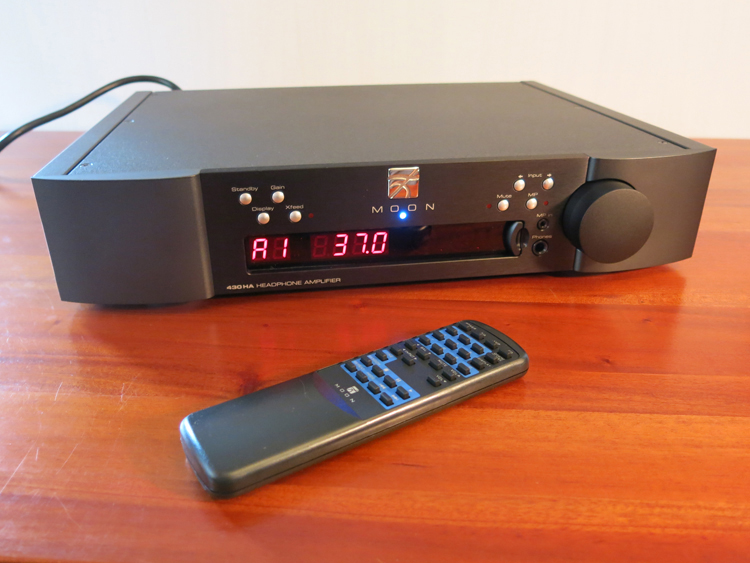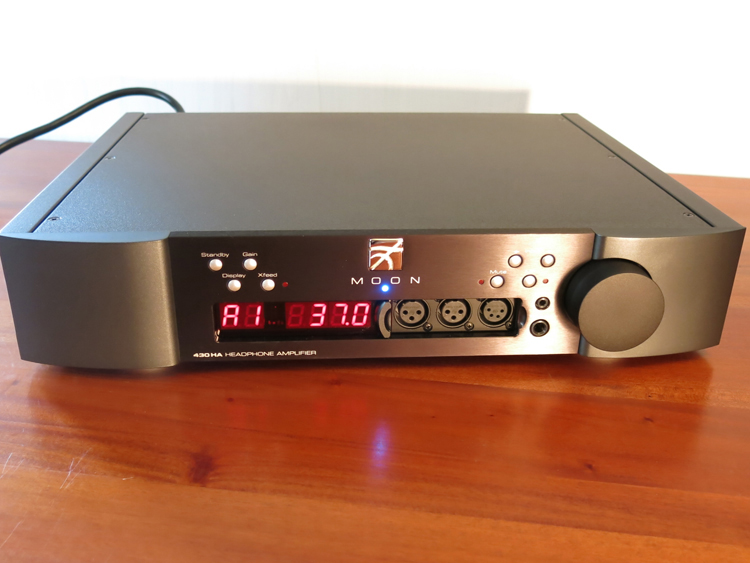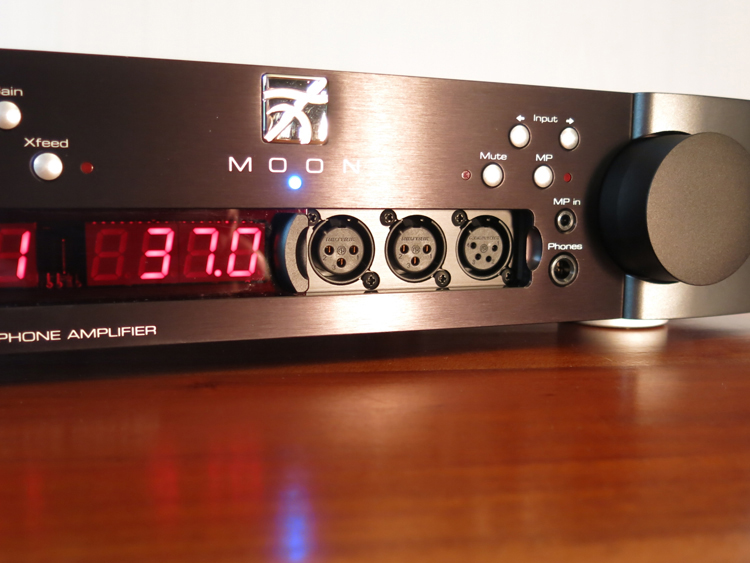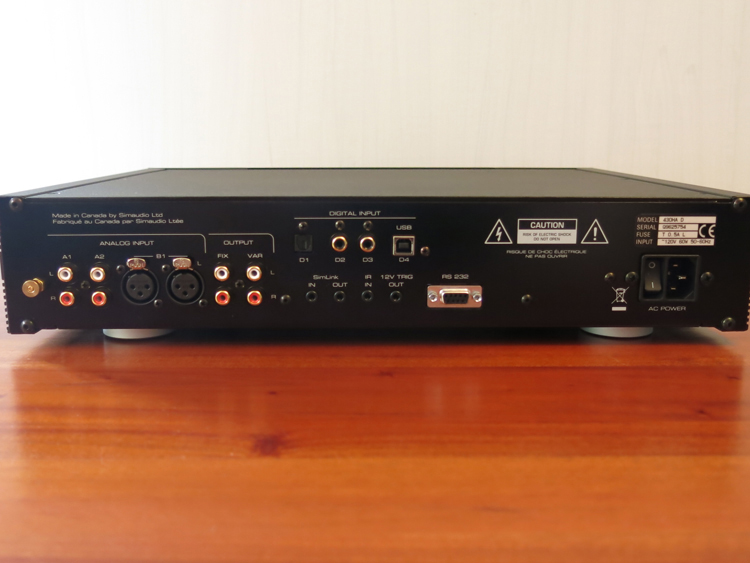If you have sufficient dollars and shelf space and some quality headphones, this beauty will connect you directly to your music collection. Adding the optional DAC adds a bit to the cost but answers the shelf-space question with a strong ‘Yes’.

MOON by Simaudio Neo 430HA Headphone Amplifier
- Excellent build quality
- Sophisticated circuit design
- Multiple connection options
- Large footprint
I think we’re in a sort of golden age of headphones, if headphones can have a golden age. Certainly it will go on for a while if for no other reason than a good set of cans should last a long time. But will everyone keep making them? And introducing new and better models? Same questions for headphone amps.
Maximum Output Power per Channel:
8 Watts
Headphone Impedance:
600 Ohms
Inputs:
1 balanced XLR Input and 3 Single-ended Line-level Inputs, Including A Front-Mounted 1/8″ Mini-Jack For Personal Media Players
Frequency Response:
20 Hz – 20 kHz ±0.1 dB, – 3 dB at 100 kHz
THD @ 1 kHz:
0dBFS (A-weighted) 0.005%
Intermodulation Distortion:
0.005%
Signal-to-Noise Ratio:
120 dB
Crosstalk:
110dB
Input/Output Impedance:
22 kOhms / 1.25 Ohms
Weight:
15 Pounds
Dimensions:
3.5″ H x 16.9″ W x 13.8″ D
Weight:
15 Pounds
MSRP:
$4,300
Company:
SECRETS Tags:
DAC, Headphone Amp, Simaudio, Moon by Simaudio, Beyerdynamic, Balanced, Crossfeed
MOON by Simaudio’s Neo 430HA is meant to be a reference product; aimed at the top of the market and presumably not bettered any time soon. Simaudio wasn’t the first to this market by a long shot but the inclusion of technologies that they have been developing during their 35 years of business makes them a formidable competitor.
As part of MOON by Simaudio’s Neo line the 430HA is officially in their more-affordable set of products but it has received two important bits of technology from their less-affordable line (Evolution). Specifically the M-LoVo voltage regulator for low voltage supplies and M-eVOL2 discrete volume control. The M-LoVo trickles down from the Evolution series 810LP Phono Preamplifier and 740P Preamplifier while the M-eVOL2 is used throughout the Evolution series.
I’m very happy to see Simaudio and other audio manufactures utilizing the multiple stage voltage regulation idea. Ten years ago it seemed like Naim was the only proponent of this key idea. The 430HA uses four stages of their M-LoVo circuit between the power supply (already conventionally regulated I presume) and the audio circuit board.
This Canadian audio manufacturer has always had a way with volume controls. Here they are using DAC chips in a novel way. The reference voltage input to the DAC chip is usually held constant but here it is used as the input signal to be amplified (controlled as the volume control). The digital input to the DAC chip is then varied according to the position of the volume knob thereby selecting the desired multiplication factor on the input signal. No moving parts and 530 distinct volume settings.
Unique to the 430HA is the amplifier circuit. A headphone represents a different kind of load than a loudspeaker simply because headphone drivers are small and lightweight (if not they would be uncomfortable amongst other problems). This created an opportunity to design a transconductance amp into the 430HA. Transconductance means that the input voltage is converted to a proportional output current rather than simply a larger voltage.
While this current is used to drive a final stage that ultimately provides a (proportional) voltage, the advantage of the transconductance circuit is high input sensitivity and slew rate which are ideal for the personal listening experience of headphones. The other major feature of this amplifier circuit is the hefty output of 8 watts per channel balanced (4 watts single ended). Typically a headphone amp will provide less than 1 watt. With so much power available I asked if the 430HA could drive highly sensitive speakers, the answer was ‘no’ so I didn’t try it.


Two other much appreciated features are a selectable gain button on the front panel and a selectable crossfeed circuit.
For the optional DAC, MOON by Simaudio uses the ever popular ES9018K2M SABRE32 Reference DAC from ESS. It is the same (optional) DAC and associated circuitry used in the Neo 340i integrated and Neo 350P preamp.
I used the 430HA both as a headphone amp (balanced and unbalanced connections) and as a DAC in my system. In making the connections to my preamp – a P8 (also ‘MOON by Simaudio’ – in this case part of the Evolution line but not the latest generation) I found myself wishing for one more balanced connection somewhere. The 430HA has a balanced input and no balanced line-level outs. My P8 has no balanced line-level outs either so I was left with no way to take advantage of the balanced inputs on the 430HA. A first-world problem if there ever was one, but frustrating to not be able to take advantage of one half of the amplifier circuit, at least in terms of external sources like my phono stage.
There seems to be a fervor for headphones and headphone amps on the Internet that is about ten times that for traditional systems. This is probably due to the fact that if your primary system is streaming from a computer through headphones, by definition you are sitting in front of said computer while listening; so you might as well blog about it. If you’ve got a turntable, on the other hand, you are on the couch, you get up to change the record or to go to the bathroom, not post on the Internet. It also has something to do with the smaller price and form factor for headphones and headphone amps – it’s easier to own more than one. That might not be so true of the 430HA which runs $4300 with the included DAC ($3500 without the DAC) and takes up precisely one stereo-rack shelf (ie, doesn’t fit on the average computer desk).
I tried a variety of ‘phones but I want to start with the best. Even though I was using the 430HA as part of my living room stereo I still managed to spend a fair amount of time on the Interweb while listening. All of the cans in my collection sounded great but what would be best? In reading a bunch of headphone sites it’s pretty clear that the prevailing favorite set out there is the Beyerdynamic T1. I should say that I was among the first to hear orthodynamic cans at the 2010 RMAF and I get it, I really do. The Audezes that I heard then and the Oppo PM-2’s that I tried with the 430HA are of a different order. Well not quite, more like a different character. In other words, all speakers have their own flavor of coloration and same is true for headphones. Even the planar magnetics. It might be that the type of color that the Beyerdynamics offer is more just what I’m used to. They are also light and comfortable.

So – how did they sound through the 430HA? Fantastic. The thing about the T1s that is very rare in the world of headphones is a sense of soundstage. It might just be the unique way the drivers are angled within the earpiece, or the fact that the drivers are super-fast or the big magnets that give the name. I tried a recently purchased LP of Spiritualized Live from Royal Albert Hall, what a record this is!
With the 430HA and the T1s the incredibly dense wall-of-sound with horns, guitars, bass, piano and drums all played at full volume was in its full glory with all these instruments distinct and beautiful against the back drop of all of the others. When the music fell into one of its quiet passages with Jason Pierce’s voice at the fore, I was there. I have requested the version two of the T1s (not called T2 as you might think) but seems they are not actually available yet. This new version comes with a detachable cord and optional balanced cable so I’m very much looking forward to trying them with the 430HA.
I also tried ‘phones from my collection. I have a love/hate relationship with my Grado 325is. They certainly have a midrange magic and with the 430HA’s powerful grip the magic extended higher and lower than I have ever heard through these guys. But that didn’t change the fact that the Grados are not comfortable! The rough foam pads limit the amount of time I want to spend with them.
For this review the only set of balanced cans I could get my hands on (thanks again Stereotypes Audio in Portland, OR) was the Oppo PM-2. Balanced or unbalanced the relatively lightweight planar magnetic drivers in the PM-2s delivered midrange textures and timbre way beyond the Beyerdynamics. If the BDs allow each instrument its own space, the PM-2s plucked each instrument out of the mix, punched it up and then put it back with at least a foot of space around it.

This happens mostly in the mids and lows, not as much in the highs which is part of why I still prefer a really well executed dynamic driver headphone over most planar magnetics that I’ve heard. Still, listening to a vinyl record that is full of choice mid-range effects and chunky bass such as Blonde Redhead’s Barragon, the midrange of the PM-2s with the 430HA was magical, presenting sounds that were lost in the background with other ‘phones.
The 430HA has a crossfeed circuit easily selected from the front panel. The effect is subtle as it should be. The purpose of such a circuit is to reduce fatigue that might result from the unnatural separation of the two stereo channels as experienced through headphones. If a crossfeed circuit is working, you don’t notice that it’s there and you listen longer. With or without crossfeed I was usually so enamored with what I was hearing there was no thought other than what to listen to next.
With all these ‘phones was I able to discern the sound of the 430HA itself? Don’t know that I did. Let’s just say it’s a very neutral piece with just the right amount of mystery. Back in the day, Simaudio gear was touted as bringing the tube sound to solid state. At this point a lot of other solid state manufactures have caught up. What I hear in this piece is just a bit of mystery and intrigue that draws me into the music. The more technical term for that (though it barely qualifies) would be “black background” which results from a low noise floor. Highs and lows are all there of course and each instrument or voice has its own space.
I spent a lot of time using the 430HA as a DAC driven by my Parasound CD1 and connected in a single-ended fashion to the aforementioned P8 preamp. The main thing I noticed with the 430HA and appreciated to no end was the solidity of the image. It was just easy to hear music and not be fatigued by any kind of digititus or blur between instruments. The end result was some of the most fatigue-free digital listening I have ever experienced.
While I’m confident that the term ‘solidity of image’ is a good one to describe what I was hearing (or not hearing some digital artifact perhaps) I still wish I had a more thorough description because I think it’s very important. I pinged Lionel Goodfield of Simaudio for an explanation and he pointed me at a white paper on the 430HA that described the oversize transformers, voltage regulation, etc. Maybe the power supply really is of a different order than that in either the Parasound or my Benchmark DAC2 but I’m suspecting something in the digital realm because I’ve noticed a similar effect in Simaudio’s MOON line of streaming solutions. The Benchmark uses the same DAC chip as the 430HA so the difference is somewhere in the surrounding circuitry.

On other fronts, soundstage and timbre, I was prepared to say that the Benchmark and Parasound were the winners but I realized I hadn’t tried much in the way of different interconnects out of the Neo 430HA. For both of the former sources I use a balanced Nordost Blue Heaven. With no balanced output available, I used what I had on hand for single-ended interconnects: a pro-audio cable of unknown brand, Chord Crimson VEE and a set of vintage Acoustic Research AR-1s. The last one was the clear winner and erased any significant differences in timbre, texture and soundstage between the three sources.
There are differences I should say but they depended a bit on the disc I was playing and weren’t enough to say one of these was the better of the others in these regards. Using the AR-1s the 430HA had a just slightly chunky character that I favor, but the solid soundstage is something the others couldn’t match.
The owner’s manual from MOON by Simaudio advises trying different high quality interconnects and power cords and I couldn’t agree more. But it’s not always a clear or significant difference. Rather than an A/B test, the real test is: how long do you listen and how much do you enjoy it? This is the especially true for power cords where the benefit (if any) will be in the lower-noise-floor arena. I did most of my listening with Shunyata’s Venum 3. Even with A/B testing the background was deeper and blacker than with the stock cord.
A note on the headphone wars: The T1s are named for the one Tesla of magnetic flux that can be measured in the heart of the driver. Recently Audeze announced a set of cans with a 1.5T measurement. Ok great, but ummm, we’re talking about an electro-magnetic field in close proximity to our brain, for hours on end (if we’re enjoying the music). Audio frequencies should be much more benign than those used for cell phone transmission (for instance) but after listening for a while I could feel something from the T1s and the Oppo PM-2’s, not quite as buzzy as the feeling I get from a cell phone but a similar feeling just inside my ears.

THE MOON BY SIMAUDIO are the Best Headphone Amp you can get.
- Incredible, commanding power from a headphone amp
- Unbalanced plus two types of balanced connection to connect with any headphone
- Optional DAC is an exceptional implementation using the renowned SABRE32 Reference DAC chip by ESS
- Balanced line level outputs
- More balanced headphones in the market
The MOON by Simaudio Neo 430HA takes significant shelf space as well as monetary investment. And while I had the sample for review, MOON by Simaudio introduced the smaller and less expensive 230HAD which is certainly worthy of investigation. But if you’ve got the scratch and the space, the ample power output and the multitude of headphone connection options make the 430HA a keeper. You can grow your headphone collection or even better, your music collection, with confidence that you’ve got the right connection for both.



